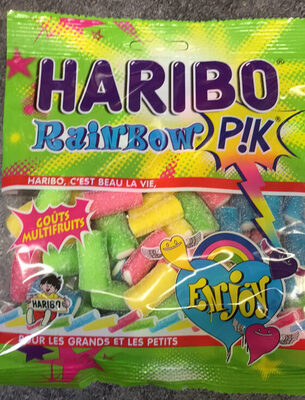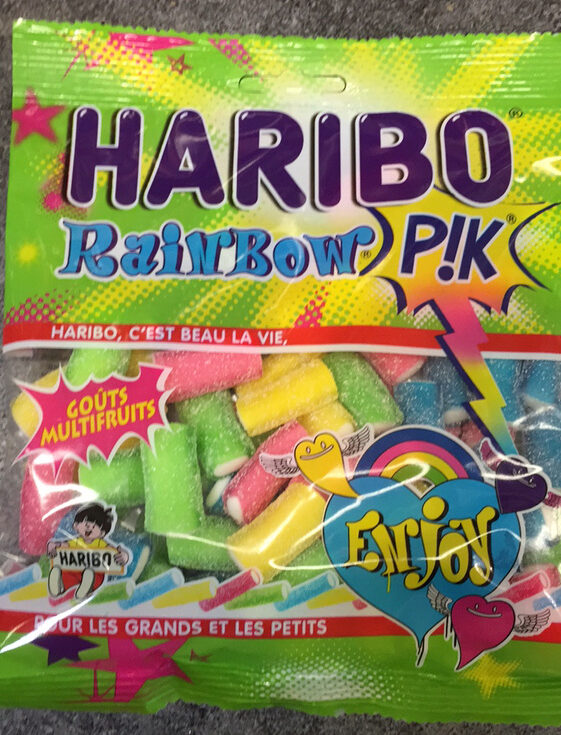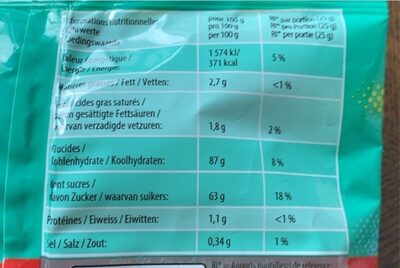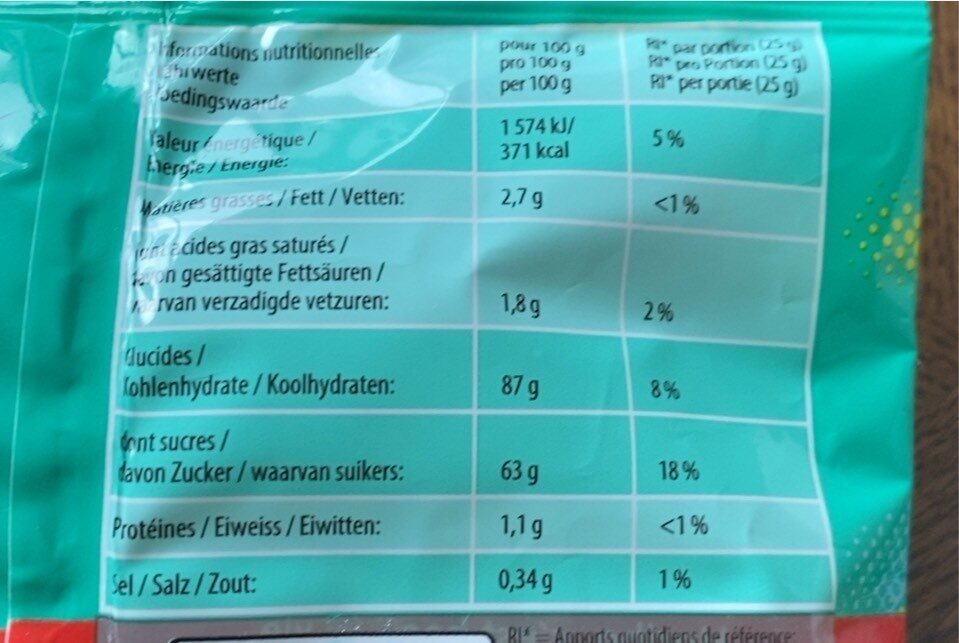Help us make food transparency the norm!
As a non-profit organization, we depend on your donations to continue informing consumers around the world about what they eat.
The food revolution starts with you!
Rainbow Pik - Haribo - 200 g
Rainbow Pik - Haribo - 200 g
This product page is not complete. You can help to complete it by editing it and adding more data from the photos we have, or by taking more photos using the app for Android or iPhone/iPad. Thank you!
×
Barcode: 3103220035221 (EAN / EAN-13)
Common name: Confiseries fantaisies acidifiées
Quantity: 200 g
Packaging: fr:Sachet en plastique
Brands: Haribo
Categories: Snacks, Sweet snacks, Confectioneries, Candies, Gummi candies, Acid gummy candies
Stores: Magasins U, carrefour.fr
Countries where sold: France, Switzerland
Matching with your preferences
Health
Ingredients
-
35 ingredients
sugar, glucose syrup, maize starch, humectants: sorbitol, sorbitol syrup, wheat flour , dextrose, wheat starch , grease palm, acidifying: citric acid, malic acid, corrector of acidity: citrate, tricalcium, malate, sodium acid pyrophosphate, trisodium citrate, glazing agent: carnauba wax, gelatine, emulsifier: mono - and diglycerides of fatty acids, flavouring, concentrates of fruits and plants: sweet potato, apple, blackcurrant, radish, colours: curcumin, patent blue v, luteinAllergens: Apple, Gluten
Food processing
-
Ultra processed foods
Elements that indicate the product is in the 4 - Ultra processed food and drink products group:
- Additive: E100 - Curcumin
- Additive: E131 - Patent blue v
- Additive: E161b - Lutein
- Additive: E420 - Sorbitol
- Additive: E428 - Gelatine
- Additive: E450 - Diphosphates
- Additive: E471 - Mono- and diglycerides of fatty acids
- Additive: E903 - Carnauba wax
- Ingredient: Colour
- Ingredient: Dextrose
- Ingredient: Emulsifier
- Ingredient: Flavouring
- Ingredient: Glazing agent
- Ingredient: Glucose
- Ingredient: Glucose syrup
- Ingredient: Humectant
Food products are classified into 4 groups according to their degree of processing:
- Unprocessed or minimally processed foods
- Processed culinary ingredients
- Processed foods
- Ultra processed foods
The determination of the group is based on the category of the product and on the ingredients it contains.
Additives
-
E131 - Patent blue v
Patent Blue V: Patent Blue V, also called Food Blue 5, Sulphan Blue, Acid Blue 3, L-Blau 3, C-Blau 20, Patentblau V, Sky Blue, or C.I. 42051 and is a dark bluish synthetic triphenylmethane dye used as a food coloring. As a food additive, it has E number E131. It is a sodium or calcium salt of [4--α--4-diethylaminophenyl--5-hydroxy- 2‚4-disulfophenylmethylidene--2‚5-cyclohexadien-1-ylidene] diethylammonium hydroxide inner salt.Source: Wikipedia
-
E296 - Malic acid
Malic acid: Malic acid is an organic compound with the molecular formula C4H6O5. It is a dicarboxylic acid that is made by all living organisms, contributes to the pleasantly sour taste of fruits, and is used as a food additive. Malic acid has two stereoisomeric forms -L- and D-enantiomers-, though only the L-isomer exists naturally. The salts and esters of malic acid are known as malates. The malate anion is an intermediate in the citric acid cycle.Source: Wikipedia
-
E330 - Citric acid
Citric acid is a natural organic acid found in citrus fruits such as lemons, oranges, and limes.
It is widely used in the food industry as a flavor enhancer, acidulant, and preservative due to its tart and refreshing taste.
Citric acid is safe for consumption when used in moderation and is considered a generally recognized as safe (GRAS) food additive by regulatory agencies worldwide.
-
E331 - Sodium citrates
Sodium citrate: Sodium citrate may refer to any of the sodium salts of citrate -though most commonly the third-: Monosodium citrate Disodium citrate Trisodium citrateThe three forms of the salt are collectively known by the E number E331. Sodium citrates are used as acidity regulators in food and drinks, and also as emulsifiers for oils. They enable cheeses to melt without becoming greasy.Source: Wikipedia
-
E331iii - Trisodium citrate
Sodium citrate: Sodium citrate may refer to any of the sodium salts of citrate -though most commonly the third-: Monosodium citrate Disodium citrate Trisodium citrateThe three forms of the salt are collectively known by the E number E331. Sodium citrates are used as acidity regulators in food and drinks, and also as emulsifiers for oils. They enable cheeses to melt without becoming greasy.Source: Wikipedia
-
E420 - Sorbitol
Sorbitol: Sorbitol --, less commonly known as glucitol --, is a sugar alcohol with a sweet taste which the human body metabolizes slowly. It can be obtained by reduction of glucose, which changes the aldehyde group to a hydroxyl group. Most sorbitol is made from corn syrup, but it is also found in nature, for example in apples, pears, peaches, and prunes. It is converted to fructose by sorbitol-6-phosphate 2-dehydrogenase. Sorbitol is an isomer of mannitol, another sugar alcohol; the two differ only in the orientation of the hydroxyl group on carbon 2. While similar, the two sugar alcohols have very different sources in nature, melting points, and uses.Source: Wikipedia
-
E420ii - Sorbitol syrup
Sorbitol: Sorbitol --, less commonly known as glucitol --, is a sugar alcohol with a sweet taste which the human body metabolizes slowly. It can be obtained by reduction of glucose, which changes the aldehyde group to a hydroxyl group. Most sorbitol is made from corn syrup, but it is also found in nature, for example in apples, pears, peaches, and prunes. It is converted to fructose by sorbitol-6-phosphate 2-dehydrogenase. Sorbitol is an isomer of mannitol, another sugar alcohol; the two differ only in the orientation of the hydroxyl group on carbon 2. While similar, the two sugar alcohols have very different sources in nature, melting points, and uses.Source: Wikipedia
-
E450 - Diphosphates
Diphosphates (E450) are food additives often utilized to modify the texture of products, acting as leavening agents in baking and preventing the coagulation of canned food.
These salts can stabilize whipped cream and are also found in powdered products to maintain their flow properties. They are commonly present in baked goods, processed meats, and soft drinks.
Derived from phosphoric acid, they're part of our daily phosphate intake, which often surpasses recommended levels due to the prevalence of phosphates in processed foods and drinks.
Excessive phosphate consumption is linked to health issues, such as impaired kidney function and weakened bone health. Though diphosphates are generally regarded as safe when consumed within established acceptable daily intakes, it's imperative to monitor overall phosphate consumption to maintain optimal health.
-
E471 - Mono- and diglycerides of fatty acids
Mono- and diglycerides of fatty acids (E471), are food additives commonly used as emulsifiers in various processed foods.
These compounds consist of glycerol molecules linked to one or two fatty acid chains, which help stabilize and blend water and oil-based ingredients. E471 enhances the texture and shelf life of products like margarine, baked goods, and ice cream, ensuring a smooth and consistent texture.
It is generally considered safe for consumption within established regulatory limits.
-
E903 - Carnauba wax
Carnauba wax: Carnauba -; Portuguese: carnaúba [kaʁnɐˈubɐ]-, also called Brazil wax and palm wax, is a wax of the leaves of the palm Copernicia prunifera -Synonym: Copernicia cerifera-, a plant native to and grown only in the northeastern Brazilian states of Piauí, Ceará, Maranhão, Bahia, and Rio Grande do Norte. It is known as "queen of waxes" and in its pure state, usually comes in the form of hard yellow-brown flakes. It is obtained from the leaves of the carnauba palm by collecting and drying them, beating them to loosen the wax, then refining and bleaching the wax.Source: Wikipedia
Ingredients analysis
-
May contain palm oil
Ingredients that may contain palm oil: E471
-
Non-vegan
Non-vegan ingredients: E428Some ingredients could not be recognized.
We need your help!
You can help us recognize more ingredients and better analyze the list of ingredients for this product and others:
- Edit this product page to correct spelling mistakes in the ingredients list, and/or to remove ingredients in other languages and sentences that are not related to the ingredients.
- Add new entries, synonyms or translations to our multilingual lists of ingredients, ingredient processing methods, and labels.
If you would like to help, join the #ingredients channel on our Slack discussion space and/or learn about ingredients analysis on our wiki. Thank you!
-
Non-vegetarian
Non-vegetarian ingredients: E428Some ingredients could not be recognized.
We need your help!
You can help us recognize more ingredients and better analyze the list of ingredients for this product and others:
- Edit this product page to correct spelling mistakes in the ingredients list, and/or to remove ingredients in other languages and sentences that are not related to the ingredients.
- Add new entries, synonyms or translations to our multilingual lists of ingredients, ingredient processing methods, and labels.
If you would like to help, join the #ingredients channel on our Slack discussion space and/or learn about ingredients analysis on our wiki. Thank you!
-
Details of the analysis of the ingredients
We need your help!
Some ingredients could not be recognized.
We need your help!
You can help us recognize more ingredients and better analyze the list of ingredients for this product and others:
- Edit this product page to correct spelling mistakes in the ingredients list, and/or to remove ingredients in other languages and sentences that are not related to the ingredients.
- Add new entries, synonyms or translations to our multilingual lists of ingredients, ingredient processing methods, and labels.
If you would like to help, join the #ingredients channel on our Slack discussion space and/or learn about ingredients analysis on our wiki. Thank you!
: sugar, glucose syrup, maize starch, humectants (sorbitol), sorbitol syrup, wheat flour, dextrose, wheat starch, grease palm, acidifying (citric acid), malic acid, corrector of acidity (citrate), tricalcium, malate, sodium acid pyrophosphate, trisodium citrate, glazing agent (carnauba wax), gelatine, emulsifier (mono- and diglycerides of fatty acids), flavouring, of fruits, plants (sweet potato), apple, blackcurrant, radish, colours (curcumin), patent blue v, lutein- sugar -> en:sugar - vegan: yes - vegetarian: yes - ciqual_proxy_food_code: 31016 - percent_min: 3.57142857142857 - percent_max: 100
- glucose syrup -> en:glucose-syrup - vegan: yes - vegetarian: yes - ciqual_proxy_food_code: 31016 - percent_min: 0 - percent_max: 50
- maize starch -> en:corn-starch - vegan: yes - vegetarian: yes - ciqual_food_code: 9510 - percent_min: 0 - percent_max: 33.3333333333333
- humectants -> en:humectant - percent_min: 0 - percent_max: 25
- sorbitol -> en:e420 - vegan: yes - vegetarian: yes - percent_min: 0 - percent_max: 25
- sorbitol syrup -> en:e420ii - vegan: yes - vegetarian: yes - percent_min: 0 - percent_max: 20
- wheat flour -> en:wheat-flour - vegan: yes - vegetarian: yes - ciqual_proxy_food_code: 9410 - percent_min: 0 - percent_max: 16.6666666666667
- dextrose -> en:dextrose - vegan: yes - vegetarian: yes - ciqual_proxy_food_code: 31016 - percent_min: 0 - percent_max: 14.2857142857143
- wheat starch -> en:wheat-starch - vegan: yes - vegetarian: yes - ciqual_proxy_food_code: 9510 - percent_min: 0 - percent_max: 12.5
- grease palm -> en:grease-palm - percent_min: 0 - percent_max: 11.1111111111111
- acidifying -> en:acidifying - percent_min: 0 - percent_max: 10
- citric acid -> en:e330 - vegan: yes - vegetarian: yes - percent_min: 0 - percent_max: 10
- malic acid -> en:e296 - vegan: yes - vegetarian: yes - percent_min: 0 - percent_max: 9.09090909090909
- corrector of acidity -> en:acidity-regulator - percent_min: 0 - percent_max: 8.33333333333333
- citrate -> en:citrate - percent_min: 0 - percent_max: 8.33333333333333
- tricalcium -> en:tricalcium - percent_min: 0 - percent_max: 7.69230769230769
- malate -> en:malate - percent_min: 0 - percent_max: 7.14285714285714
- sodium acid pyrophosphate -> en:e450i - vegan: yes - vegetarian: yes - percent_min: 0 - percent_max: 6.66666666666667
- trisodium citrate -> en:e331iii - vegan: yes - vegetarian: yes - percent_min: 0 - percent_max: 6.25
- glazing agent -> en:glazing-agent - percent_min: 0 - percent_max: 5.88235294117647
- carnauba wax -> en:e903 - vegan: yes - vegetarian: yes - percent_min: 0 - percent_max: 5.88235294117647
- gelatine -> en:e428 - vegan: no - vegetarian: no - percent_min: 0 - percent_max: 5.55555555555556
- emulsifier -> en:emulsifier - percent_min: 0 - percent_max: 5.26315789473684
- mono- and diglycerides of fatty acids -> en:e471 - vegan: maybe - vegetarian: maybe - from_palm_oil: maybe - percent_min: 0 - percent_max: 5.26315789473684
- flavouring -> en:flavouring - vegan: maybe - vegetarian: maybe - percent_min: 0 - percent_max: 5
- of fruits -> en:fruit - vegan: yes - vegetarian: yes - percent_min: 0 - percent_max: 4.76190476190476
- plants -> en:plant - vegan: yes - vegetarian: yes - percent_min: 0 - percent_max: 4.54545454545455
- sweet potato -> en:sweet-potato - vegan: yes - vegetarian: yes - ciqual_food_code: 4101 - percent_min: 0 - percent_max: 4.54545454545455
- apple -> en:apple - vegan: yes - vegetarian: yes - ciqual_food_code: 13050 - percent_min: 0 - percent_max: 4.34782608695652
- blackcurrant -> en:blackcurrant - vegan: yes - vegetarian: yes - ciqual_food_code: 13007 - percent_min: 0 - percent_max: 4.16666666666667
- radish -> en:radish - vegan: yes - vegetarian: yes - ciqual_food_code: 20045 - percent_min: 0 - percent_max: 4
- colours -> en:colour - percent_min: 0 - percent_max: 3.84615384615385
- curcumin -> en:e100 - vegan: yes - vegetarian: yes - percent_min: 0 - percent_max: 3.84615384615385
- patent blue v -> en:e131 - vegan: yes - vegetarian: yes - percent_min: 0 - percent_max: 3.7037037037037
- lutein -> en:e161b - vegan: yes - vegetarian: yes - percent_min: 0 - percent_max: 3.57142857142857
Nutrition
-
Poor nutritional quality
⚠ ️Warning: the amount of fruits, vegetables and nuts is not specified on the label, it was estimated from the list of ingredients: 0This product is not considered a beverage for the calculation of the Nutri-Score.
Positive points: 0
- Proteins: 0 / 5 (value: 1.1, rounded value: 1.1)
- Fiber: 0 / 5 (value: 0, rounded value: 0)
- Fruits, vegetables, nuts, and colza/walnut/olive oils: 0 / 5 (value: 6.60972935904169e-05, rounded value: 0)
Negative points: 16
- Energy: 4 / 10 (value: 1574, rounded value: 1574)
- Sugars: 10 / 10 (value: 63, rounded value: 63)
- Saturated fat: 1 / 10 (value: 1.8, rounded value: 1.8)
- Sodium: 1 / 10 (value: 136, rounded value: 136)
The points for proteins are not counted because the negative points are greater or equal to 11.
Nutritional score: (16 - 0)
Nutri-Score:
-
Nutrient levels
-
Fat in low quantity (2.7%)
What you need to know- A high consumption of fat, especially saturated fats, can raise cholesterol, which increases the risk of heart diseases.
Recommendation: Limit the consumption of fat and saturated fat- Choose products with lower fat and saturated fat content.
-
Saturated fat in moderate quantity (1.8%)
What you need to know- A high consumption of fat, especially saturated fats, can raise cholesterol, which increases the risk of heart diseases.
Recommendation: Limit the consumption of fat and saturated fat- Choose products with lower fat and saturated fat content.
-
Sugars in high quantity (63%)
What you need to know- A high consumption of sugar can cause weight gain and tooth decay. It also augments the risk of type 2 diabetes and cardio-vascular diseases.
Recommendation: Limit the consumption of sugar and sugary drinks- Sugary drinks (such as sodas, fruit beverages, and fruit juices and nectars) should be limited as much as possible (no more than 1 glass a day).
- Choose products with lower sugar content and reduce the consumption of products with added sugars.
-
Salt in moderate quantity (0.34%)
What you need to know- A high consumption of salt (or sodium) can cause raised blood pressure, which can increase the risk of heart disease and stroke.
- Many people who have high blood pressure do not know it, as there are often no symptoms.
- Most people consume too much salt (on average 9 to 12 grams per day), around twice the recommended maximum level of intake.
Recommendation: Limit the consumption of salt and salted food- Reduce the quantity of salt used when cooking, and don't salt again at the table.
- Limit the consumption of salty snacks and choose products with lower salt content.
-
-
Nutrition facts
Nutrition facts As sold
for 100 g / 100 mlAs sold
per serving (25 g)Compared to: Acid gummy candies Energy 1,574 kj
(371 kcal)394 kj
(92 kcal)+9% Fat 2.7 g 0.675 g +493% Saturated fat 1.8 g 0.45 g +653% Carbohydrates 87 g 21.8 g +8% Sugars 63 g 15.8 g +8% Fiber 0 g 0 g -100% Proteins 1.1 g 0.275 g -66% Salt 0.34 g 0.085 g +80% Fruits‚ vegetables‚ nuts and rapeseed‚ walnut and olive oils (estimate from ingredients list analysis) 0 % 0 %
Environment
-
Eco-Score B - Low environmental impact
⚠ ️Select a country in order to include the full impact of transportation.The Eco-Score is an experimental score that summarizes the environmental impacts of food products.→ The Eco-Score was initially developped for France and it is being extended to other European countries. The Eco-Score formula is subject to change as it is regularly improved to make it more precise and better suited to each country.Life cycle analysis
-
Average impact of products of the same category: A (Score: 89/100)
Category: Jelly candy
Category: Jelly candy
- PEF environmental score: 0.21 (the lower the score, the lower the impact)
- including impact on climate change: 1.57 kg CO2 eq/kg of product
Stage Impact Agriculture
51.7 %Processing
31.1 %Packaging
7.6 %Transportation
7.3 %Distribution
2.3 %Consumption
0.0 %
Bonuses and maluses
-
Missing origins of ingredients information
Malus: -5
⚠ ️ The origins of the ingredients of this product are not indicated.
If they are indicated on the packaging, you can modify the product sheet and add them.
If you are the manufacturer of this product, you can send us the information with our free platform for producers.
-
Packaging with a medium impact
Malus: -10
Shape Material Recycling Impact Bag Plastic High
Eco-Score for this product
-
Impact for this product: B (Score: 74/100)
Product: Rainbow Pik - Haribo - 200 g
Life cycle analysis score: 89
Sum of bonuses and maluses: -15
Final score: 74/100
-
Carbon footprint
-
Equal to driving 0.8 km in a petrol car
157 g CO² per 100g of product
The carbon emission figure comes from ADEME's Agribalyse database, for the category: Jelly candy (Source: ADEME Agribalyse Database)
Stage Impact Agriculture
36.9 %Processing
38.1 %Packaging
11.9 %Transportation
12.0 %Distribution
1.1 %Consumption
0.0 %
Packaging
-
Packaging with a medium impact
-
Packaging parts
Bag (Plastic)
-
Packaging materials
Material % Packaging weight Packaging weight per 100 g of product Plastic
-
Transportation
-
Origins of ingredients
Missing origins of ingredients information
⚠ ️ The origins of the ingredients of this product are not indicated.
If they are indicated on the packaging, you can modify the product sheet and add them.
If you are the manufacturer of this product, you can send us the information with our free platform for producers.Add the origins of ingredients for this product Add the origins of ingredients for this product
Report a problem
-
Incomplete or incorrect information?
Category, labels, ingredients, allergens, nutritional information, photos etc.
If the information does not match the information on the packaging, please complete or correct it. Open Food Facts is a collaborative database, and every contribution is useful for all.
Data sources
Product added on by openfoodfacts-contributors
Last edit of product page on by itsjustruby.
Product page also edited by driveoff, feat, foodrepo, inf, kiliweb, magasins-u, openfood-ch-import, quechoisir, roboto-app, segundo, telperion87, yuka.UXFVK0tvTXJnOUF3dThNWDJ6YU8yY2dyeThPR0JGMitOOXMrSVE9PQ, yuka.VFlZeFBvWXhwZjhzbjhZVnhUcnBvK0JNK0xHeEJWeXhFdU1VSVE9PQ, yuka.VGYwdlQ3WVJ2L05YcDg5azNoTDFwL2x1eHFlUllWdVRkdk5JSUE9PQ, yuka.Vm9VQkhydGVuTWt5c3NBUy9pdk55dU5NeEpxYlhrQzNON29ySVE9PQ, yuka.Wkk0U0VKZzdtdWxUc1BBRC9qYnovYzllNTVEd1REaVFKZkJQSUE9PQ, yuka.WkkwdkNMd0JwY2xUbTlvTTNScUV4dU5XbDhHVmZET2xLZk1PSWc9PQ, yuka.YVp3K0R2b3V2dDBFZ3NZQ3hoNk9wdkV1M29LRVdscXhGKzFQSUE9PQ, yuka.sY2b0xO6T85zoF3NwEKvll1pCcXYqDHrNkTUl1KF6-2MB6bvYY9Ps4XqMKs, yuka.sY2b0xO6T85zoF3NwEKvlmxneeuEpwL2ETPfxEHb3t23M5GwecN53I3nOqs, yuka.sY2b0xO6T85zoF3NwEKvlnJsa97asBLHNTD4vF-ZzY6WHKzZPsh564HLEao, yukafix.









